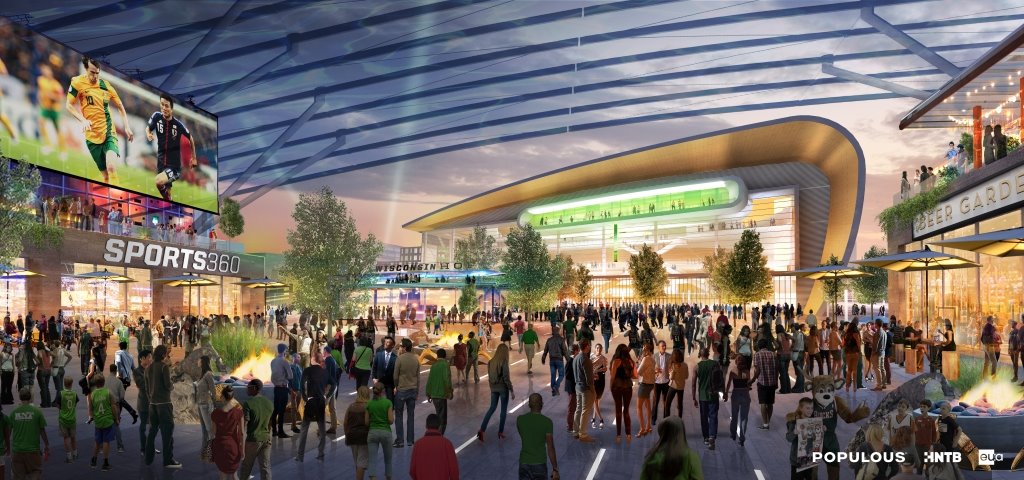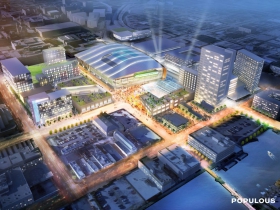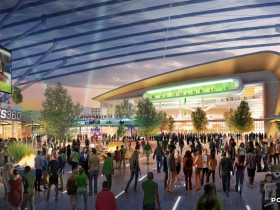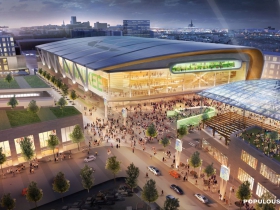Will Bucks’ Plaza Be Public or Private?
Team wants 4th Street closed, but will this create a town square or just team profits?
The Milwaukee Bucks owners are getting a generous package of tax-funded cash, land and other gifts to build their new arena development. But their requested closure of one block of N. 4th St. to better connect their planned “Live Plaza” entertainment center east of 4th St. to the new arena that will be just west of the street, has not yet been approved. It has raised concerns from some observers; among the key questions: How will the plaza be governed and what public, rather than commercial, uses it will serve?
The Bucks are lobbying hard for 4th Street to be shut down all-year, not just during the NBA season, between W. Highland and W. Juneau. They want more room for “the country’s biggest outdoor sports bar” as they’ve described it, and to increase their revenue streams. The Common Council must still approve the deal, although enough votes are reportedly pledged.
The Bucks and city officials have not involved the community in planning this plaza. In contrast, the Green Bay Packers and Village of Ashwaubenon are using community engagement to help plan a public plaza within the proposed 34-acre Titletown District. Last week, an open house about pending plans reportedly drew 300 residents and business owners, according to Packers.com. It followed sessions with “local leaders, community managers and business owners on what the public plaza at the heart of the district should comprise.”
Milwaukee’s Common Council has committed $12 million plus other infrastructure costs for the plaza. The city will own the space but “turn over control of the street to the Bucks,” Ald. Robert Bauman recently told the Milwaukee Journal Sentinel.
Dan Casanova, senior economic development specialist for Milwaukee’s Redevelopment Authority, told Urban Milwaukee the current proposal calls for the city to lease the space to the Wisconsin Center District, a state-chartered taxing authority that will own the arena. In turn, WCD would lease the plaza to the Milwaukee Bucks for 30 years. (That contract will be negotiated and signed solely by Wisconsin’s Secretary of Administration Scott Neitzel, probably by March.) Casanova said he knows of no other city-owned space under private control.
Joseph Rodriquez, a UW-Milwaukee professor of history and urban studies, calls it a dangerous precedent to let a for-profit enterprise monopolize a street: “While the Bucks claim the plan would enhance the fan experience, the real goal is to increase team revenue,” he wrote in an email. “Streets are the heart of urban commerce and should not be walled off for special interests. Other businesses do not propose permanent takeovers of public space. Sports franchises should be held to the same standard as any other enterprise.”
Neighbors have voiced concerns about closing the street. Marty Petricca, a Major Goolsby’s manager, told Fox6 he worries about losing business if traffic is diverted away from the legendary Fourth Street bar. Old World Third Street business owner Ken McNulty told the City Plan Commission that losing convenient parking on Fourth Street would deter patrons of daytime business. But when George Affeldt started to express views of the historic Turner Hall board to the plan commission, he was told to address them to the Common Council at upcoming hearings.
Ninety percent of pedestrian malls have failed; most have reopened as streets, according to research by urban planner Cole Judge in 2013.
Will this privately-run public land remain a “public forum”–where First Amendment expression is protected? As Urban Milwaukee has reported, that issue arose with private companies leasing county park land: for more than a decade these lease contracts wrongly barred any political activities from occurring on leased property. After Urban Milwaukee raised questions about this, County Corporation Counsel Paul Bargren wrote a legal opinion emphatically declaring that such language was a violation of the First Amendment.
The state’s arena bill (SB209) limits commercial uses of the entertainment plaza to ones benefiting the Bucks: “The professional basketball team or its affiliate shall be entitled to receive all revenues related to the operation or use of the sports and entertainment arena facilities, including…revenues generated from events that are held on the plaza that is part of the sports and entertainment arena facilities…” (emphasis added). The Bucks’ intended uses include food-and-beverage sales, promotional pep rallies, viewing games on Jumbotrons, ticket sales and other game-related activities.
Casanova seemed to walk a fine line in describing how public the public street would be, saying political protests or homeless people could not be barred, but suggesting street festivals and other community events would be off limits unless approved by the Bucks. Ethan Kent, an executive with the nonprofit Project for Public Spaces, told Urban Milwaukee that limiting a public plaza’s uses diminishes its value—not just for potential users but as a catalyst for local economic prosperity. He said widely diverse activities and options, including mobile food and other enterprises, attract people and spur economic vitality.
When asked what entity might ensure this plaza is governed by the same codes and principles as other public spaces, Bauman responded that at this point the WCD board “simply does not know.” Casanova said city officials want to “make sure it looks and feels open to the public.”
Urban historian and Milwaukee School of Engineering associate professor Michael Carriere challenges the approach being taken about the plaza and overall arena-district development. “In very real ways, such plans simply duplicate the urban renewal plans of the 20th century, plans drawn up by ‘experts’ without any real community input or support,” he wrote in an email. “Most cities–and understandably so–have moved beyond such models… It’s actually meant to address the interests of a single player–the Bucks. And it’s doing this in a way that counters current thinking on sustainable urban redevelopment.”
Carriere invoked the views of famed author and urban theorist Jane Jacobs, who argued that a successful public space “has to be organic, coming from the ground up and seeing spaces as part of the specific fabric of their immediate surroundings.” Jacobs also suggested you need “an enormous diversity of ingredients” mixed together, and a commitment to maintaining buildings of all sorts and ages also had to be fostered, Carriere noted, then added, “This doesn’t sound at all like the 4th Street Project.”
Bucks president Peter Feigin has argued 4th Street should closed to vehicles because it’s a “dead zone” outside of arena events. But Bauman said at a September hearing he doubts a plaza would draw pedestrians except for arena events and nightlife. He suspects it will remain deserted by day. According to Judge’s report, pedestrian malls invariably depressed commerce in low-foot-traffic areas–rather than increasing it.
But Bucks senior vice-president of communications Jake Suski told Urban Milwaukee the team’s goal is to create “a new vibrant neighborhood downtown that will be a magnet for activity year-round. We envision the plaza as a community gathering place that could be used for all sorts of events beyond when the arena is in use.” It will be designed to attract outdoor activities for the community working and living within the new development, as well as for visitors from the entire region, he adds.
Rocky Marcoux, commissioner of city development, has said he expects the plaza will serve people who eventually live and work in buildings on the 20 acres of now-public land being given to the Bucks to develop. But much of that development is not planned for a decade or so. A streetcar extension might also someday run through the plaza–one reason the city is retaining the right of way. City ownership will also make it easier to reopen the street if it fails as a pedestrian mall.
The entertainment mall will have links to Old World Third Street. That area and nearby Water Street comprise a broad nightlife zone that’s especially busy on weekends. All told, there are about 70 bars and restaurants within a half mile of the arena.
The Bucks’ U-shaped entertainment center will feature pubs and eateries—an estimated 75 percent will be franchises–surrounding a covered courtyard. Carriere is concerned: “What you have is a plan that overlooks local economic actors and interests for the sake of national chains and capital.”
Minneapolis, known for great parks, also wrangled recently over governance and usage issues regarding a proposed green space next to a stadium. The 4.2-acre public space will offer year-round uses. However, the Minnesota Vikings and the stadium authority will take over the park for about 62 days a year. MinnPost reported in 2014 that some people thought it would be “a mostly private event-space masquerading as a public park.” However, a City of Minneapolis official told Urban Milwaukee that the public will have access even during private events. The Minneapolis Park Board declined to play a role in constructing or overseeing the space, due to access and fiscal concerns. Instead, the city will manage the green. The park is credited as a major factor in Wells Fargo building a tower headquarters next to it and made a “significant’ contribution to its construction.
Designs for the 4th Street plaza and entertainment complex will be presented some time in the next few months. Citizens still have time to contact their Common Council members or express their concerns at hearings about the plaza.
Arena Project Renderings
If you think stories like this are important, become a member of Urban Milwaukee and help support real, independent journalism. Plus you get some cool added benefits.
Political Contributions Tracker
Displaying political contributions between people mentioned in this story. Learn more.
- November 2, 2019 - Robert Bauman received $250 from Peter Feigin
- November 2, 2019 - Robert Bauman received $150 from Peter Feigin
- May 20, 2016 - Robert Bauman received $100 from Ken McNulty
- March 8, 2016 - Robert Bauman received $500 from Peter Feigin
- November 18, 2015 - Robert Bauman received $100 from Ken McNulty
- September 17, 2015 - Robert Bauman received $386 from Ken McNulty
- September 4, 2014 - Robert Bauman received $100 from Ken McNulty

























75% chains is very very disappointing
Seems that the City should already have a legal opinion at hand stating that the Bucks cannot gain ownership control of the land through reversion, notwithstanding that the City has abandoned the easement through non-use as a public highway.
I don’t understand why this can’t be a clod able portion of the steet for weekend nights or game nights using retractable bollards as is often used in Europe. Full time closure seems excessive.
I’m not sure of the governance, despite doomsday predictions, NYC closed significant auto street access in Times Square with good results. Street food and other vendors merchants mix in with pedestrians, bicyclists and tourists.
Now I realize that this area is not a destination like Times Square, but I can guarantee it never will be if one private entity is controlling it. This is a way fo setting up a member only environment for the benefit of the Bucks. Guaranteed anything else featured in this space will be a loss leader, so they can pretend to be reaching out to the general public. In the worst case maybe they will try to compete with events like “Jazz in the Sqaure”.
Each of these downtown controlled entertainment venues I’ve experienced is sterile and unappealing. Louisville comes to mind.
Is there no end to the concessions that the City makes to the private sports sector? Everywhere in the country were is evidence that all these give aways are not consistent or helpful to the public’s interest or other private retail interests as well.
We used to be a leader in demonstrating how the public sector could encourage and develop public areas for the common good. Now we lag behind without even studying much less acknowledging successful projects accomplished by other cities. What a shame.
Let’s stop this corruption. Transparency in the city’s role in the bargaining with the sports sector should be a start.
I’m not optimistic about the space whatsoever. It’s going to be bland and uninspired, much like a mini-Bayshore mall.
Prove me wrong Bucks. I dare you.
As laudable as Ald. Bauman’s fight has been, he evidently is in the minority when it comes to seriously questioning this development.
@Jeff,
The place you mention in Louisville is, coincidentally, 4th Street Live! The “Live” projects (and Ballpark Village in St. Louis) have been developed along a similar model by The Cordish Companies.
http://www.4thstlive.com/dine-drink-play
The City had considered vacating 4th Street permanently but is no longer planning to do that, for reasons stated, and the street will not be encroached.
It’s more a question of whether it will function and be governed like other public spaces rather than as a de-facto extension of a commercial entertainment complex. Will it function like new (or remade) urban parks and squares such as Campus Martius in Detroit, Public Square in Cleveland, or Millennium Park?
To clarify, the current plan is that the street itself would be gone but the “right of way” would reportedly not be encroached, where all the utilities etc. are located.
@Virginia Small
I Google mapped 4 Street Live! in Louisville, the Ballpark Village in St. Louis, KC Power and Light District in Kansas City, Power Plant Live! in Baltimore, and the especially sad Xfinity Live! in Philadelphia. It’s exactly what I expected. Something that looks more at home in suburban Brookfield then downtown Milwaukee. Bland and uninspired.
I recommend everyone check them out. There is nothing worth emulating here.
I would be against this if it ever means that the Bucks can close the plaza off to pedestrians and that you have to pay admission to get inside.